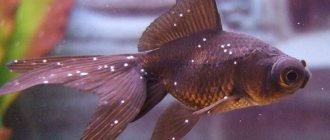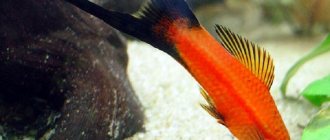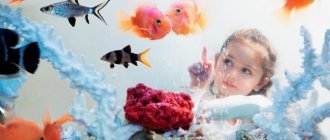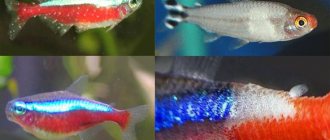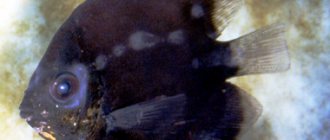Oodiniosis or ichthyophthyriosis: establishing an accurate diagnosis
Oodiniosis and ichthyophthyriosis are very similar in external signs of the disease, but their treatment is radically different, so it is important to distinguish between these two diseases.
Symptoms of oodiniosis:
- The skin of the fish is covered with fine dust. When infected with Oodinium pillularis, the color of the trophont is golden, and the shape under a microscope is teardrop-shaped. When infected with Oodinium limneticum, the color is pale yellow and the shape is oval. The picture of the disease is practically invisible to the naked eye.
- The fish behave differently: some are depressed and inactive, others restlessly scratch around the plants and rub against the ground.
- The epithelial layer of the skin is destroyed in places, and intense mucus secretion is observed. In long-tailed fish and fish with large fins, when severely affected, the fins stick together, sag, and are destroyed.
- A special feature of oodiniosis is a good appetite in fish, which persists until death.
With ichthyophthyriasis, the plaque on the body of the fish has the form of white dots, which can be seen quite clearly with the naked eye. The trophont is round in shape, ranging in size from 0.5 to 1 mm. Sick fish lose their appetite. An accurate diagnosis can only be made after examining the parasite under a microscope.
Fish that spawn, cyprinids, platies, labyrinths, cyprinids, and characins are susceptible to oodyniosis. Fish from the cichlid family are resistant, although they can be carriers of the parasite. Fry and fish that have not reached sexual maturity are more susceptible to the disease than adults.
Symptoms
Symptoms : the skin of the fish becomes dull, with a fine white-brown rash (“gold dust”), and necrosis occurs. When examining the integument of the fish through a magnifying glass, on the body and fins, some scales are bordered by small spots in the form of a golden or gray rash. With high magnification under a microscope, these “spots” are visible very clearly: pear-shaped bodies of the flagellate odonnium, which have a golden or yellowish color because they contain many chloroplasts. This means that this type of parasite is capable of photosynthesis (has characteristics of both protozoa and plants). It is recommended to pay attention to this fact: it is much easier to fight parasites in the dark (twilight is desirable, complete darkness is not necessary)!
As the disease develops, the outer covers peel off, the interray tissue of the fins is destroyed, the fins stick together and split, and soon only broken rays remain.
The fish swims spasmodically, scratching against underwater objects. Mucus is secreted abundantly. This disease does not affect the appetite of fish.
Treatment of aquarium fish for oodiniosis
If the fish are kept in normal conditions, even if the pathogen Oodinium is present in the aquarium, residents may not show symptoms of the disease. Only sometimes the fish itch against the stones, suddenly shudder or turn pale, and hang upside down. And only when the fry die do aquarists begin to look for the cause of the pestilence. Therefore, the first thing: we evaluate the health of the fish and examine the composition of the water in the aquarium.
An increase in the concentration of carbon dioxide, nitrate content and other indicators disrupts the biological balance in the aquarium, which leads to an exacerbation of the disease. When keeping fish, it is advisable to monitor various water parameters daily; this can be done simply by using test strips for water analysis.
from the manufacturer LaMotte (USA).
How to correctly diagnose oodinium disease
A preliminary diagnosis can be made based on a clinical examination of the diseased fish. However, you cannot completely rely on clinical signs of the disease alone. Oodiniumosis is a disease somewhat similar in its clinical signs to ichthyophthyriosis. Therefore, persons who do not specialize in fish diseases may well make an incorrect diagnosis.
A more accurate diagnosis can be made by examining the integument of the fish with a magnifying glass. Under magnification, small golden tubercles that border individual scales are clearly visible. Intense infestation looks like a continuous coating of these tubercles, called mealy rash. Based on such a study, a more reliable diagnosis can be made.
The final diagnosis is made based on examination of scrapings. They are taken from the body of the fish and fins, since parasites are most often localized there. To diagnose this disease, a microscopy analysis of the skin is sufficient; the gill apparatus of the fish does not need to be examined. The choice of treatment method for sick fish does not depend in any way on the type of pathogen. Oodiniumosis caused by flagellates of both species is treated in the same way.
Start
Treatment of aquarium fish from oodiniosis with bicilin-5
Treatment of aquarium fish for oodiniosis is carried out in a general aquarium or a fish tank. When there are valuable plants in the aquarium, it is advisable to treat the fish in a separate vessel. There is an opinion that the use of bicillin-5 can lead to oppression and deformation of leaves. However, 2 applications of the drug at a dosage of 750,000 units/100 l is a completely acceptable norm, which does not cause the death of flora in the aquarium.
Water, soil and vegetation are left in the aquarium without fish for 8-10 days. The water temperature is maintained at 27–28 °C, the aquarium is brightly lit for 4 days. In subsequent days, the aquarium is shaded. This creates favorable conditions for the reproduction of all cysts that are in the dormant stage. The released dinospores will not find their victims (because there are no fish in the aquarium), they will not be able to carry out photosynthesis in the dark, and bicillin-5 dissolved in water will destroy them.
Read more about the treatment of aquarium fish from oodynia with bicilin-5 in a general aquarium. The dosage of bicillin-5 on the first day is 1000,000 or 1500,000 per 100 liters of water (note - per 100 liters of water, not per 100 liter aquarium). On the second day, it is necessary to replace 30% of the water and add medications again. The treatment should be repeated after 2 days, and then after 7 days. The antibiotic acts much worse in an acidic environment; the optimal pH of water is 6.7–7.5. Water monitoring is easy to do using
LaMotte INSTA-TEST WIDE RANGE PH pH
test strips . It is also necessary to maintain strong aeration of the water, the temperature of which should not be lower than 24 °C.
Causes
Causes: Invasive disease. Pathogens are flagellates of the genus Oodinium. They enter the aquarium along with fish, plants, water and equipment from an infected aquarium. The flagellate Oodinium pillularis is a single-celled, pear-shaped, whitish-gray to yellowish-brown parasite, 20-150 µm long, covered with cilia and equipped with two flagella. It parasitizes under the epithelial layer of the skin and fins for 2-4 days, then leaves the fish, sinks to the bottom or plants, where it reproduces. Oodinium limneticum is oval in shape, slightly larger than the previous species, yellowish in color and also equipped with two flagella. It parasitizes on the surface of the skin and fins of fish, where it reproduces. At a certain period of development, both types of flagellates are covered with a protective shell (cyst) and are in a dormant stage. During this period, no medications have any effect on them. After the cyst ruptures, young flagellates—dinospores—emerge directly into the water. The disease most often affects cardinals, lalius, macropods, barbs and nanostomus, and sometimes other fish.
Treatment of aquarium fish from oodiniosis without bicillin-5
The pathogens Oodinium, which reproduce in fresh water, are sensitive to solutions of table salt. In case of a low degree of damage, the fish are placed in an aquarium filled with a 1.5–2% salt solution. If necessary, fish are given salt baths 3–4 times, but not more than once a day.
Copper salts have a detrimental effect on parasites. But we should not forget that mollusks and crustaceans are also sensitive to the effects of heavy metals and may die. The concentration of copper ions that is safe for fish and destructive for Oodinium is 0.12–0.18 mg/l, although other figures can be found in literary sources. However, it is necessary to understand that the safety of using copper-based preparations is related to water parameters such as hardness and pH, as well as the presence of dissolved organic acids.
Aquarists should regularly monitor the condition of the water in the aquarium, and the following will help them with this:
- Test strips for copper in water LaMotte INSTA-TEST COPPER
- Test strips for total water hardness LaMotte INSTA-TEST LOW RANGE TOTAL HARDNESS
- pH test strips LaMotte INSTA-TEST WIDE RANGE PH
To prepare a solution based on copper, you need to dissolve 0.5 g of citric acid in 1 liter of distilled or cold boiled water and add 4 g of copper sulfate CuSO4 * 5H2O. The prepared solution for treating fish from oodiniosis is approximately 1 mg of copper ions in 1 ml of water.
To calculate how much medicinal solution needs to be poured into the aquarium, it is necessary to multiply the concentration of copper ions by the volume of water in the aquarium. For example, you have 80 liters of water in your aquarium and you want to apply a copper concentration that is 0.15 mg/l. You need 80x0.15=12 mg of copper ions, corresponding to 12 ml of the solution you made.
The treatment period for fish from oodiniosis is 10 days. During this period, it is imperative to regularly monitor the copper content in the water in order to maintain the therapeutic concentration and prevent a shortage or excess of copper ions. If the concentration is insufficient, the treatment will not have any effect; if there is too much, all the fish may die.
Gyrodactylosis
This is another ailment that is characterized by lethargy and the appearance of a white-blue coating. At the same time, the fish compresses its fins, often touches hard surfaces with its body, and moves jerkily. The eyes become opaque, the body is covered with tiny wounds, and the fins are separated into sectors. The fish lacks air and suffers from exhaustion.
This is a signal of the presence of an infectious agent - the protozoan Gyrodactylus. The parasite is up to 0.8 mm long and clings to fish using peculiar “hooks”. It poses a particular danger to offspring.
To carry out a course of recovery, the infected individual is placed in a separate container. They use the well-known copper sulfate diluted in settled water. 15 mg per 10 liters is enough. For prevention, a common aquarium is left without the presence of fish for at least 7 days. Parasites, without “access to the body,” die. Prevention of infection of offspring with gyrodactylosis involves treating the aquarium used for spawning with regular salt (24 hours is enough).
Prevention of oodyniosis
Prevention of oodiniosis, like any disease, involves mandatory quarantine of the fish you have purchased. It’s even better to place them 3 times in a fish tank with a special solution that kills parasites. To prevent the transfer of infection, one should not forget about disinfecting new vegetation and assigning fish farming equipment to each aquarium.
Also, regularly checking water indicators makes it possible to react in time to a violation of the biological balance in the aquarium and carry out a water change. Test strips for water analysis simplify water quality control
LaMotte (USA). Testing is carried out quickly and with high accuracy.
filamentous
Filament appears when there is a large amount of iron and a lack of phosphorus, which plays an important role in nutrition. Grows in thin interlacing threads. Easily removed mechanically.
Rhizoclonium
The light green weed looks like light cotton wool. Appears in aquariums with an unknown nitrogen cycle. Disappears after biobalance is established.
Spirogyra
It consists of fragile and slimy threads. It is difficult to get rid of algae as it grows at a high rate in the aquarium. The reason for growth is excess light and lack of nutrition. Turning off the lights in combination with introducing algae-eating fish and adding medications helps.
Cladophora
Weed with short filaments. It grows with weak filtration in stagnant water, as well as with a lack of carbon dioxide.
What to do with the aquarium?
A fish disease like semolina is very contagious, so absolutely all fish are quarantined. Even if they do not have any signs of ichthyophthyriasis, this does not mean that they did not have time to catch it: most likely, ichthyosis is at an early stage of development.
A complete restart of the main aquarium is not required. The fact is that in the absence of potential victims, ichthyophthirius die after three days. To speed up this process, the temperature in the main container, as well as in the quarantine container, is raised to 34°C.
If semolina was treated in the main aquarium, then at the end of the course it is necessary to restore balance to the aquatic environment. Tests for the chemical composition will help with this, followed by drugs to regulate it or a special biofilter. The level of aeration does not decrease, the bottom and surfaces siphon. The frequency of water changes is reduced gradually and ends when necessary.
Important: it is worth paying special attention to strengthening the fish’s immunity - with the help of dietary supplements in water or complex fortified feeds.
